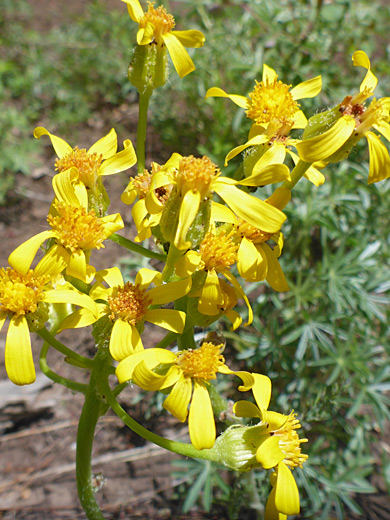Senecio Integerrimus, Tall Western Groundsel
Plants > Wildflowers > Asteraceae > Senecio Integerrimus

Tall western groundsel (senecio integerrimus var exaltatus), South Mountain, La Sal Mountains, Colorado
Common names:
Tall western groundsel, lambstongue ragwort
Family:
Scientific name:
Senecio integerrimus
Main flower color:
Range:
All of the western states apart from Texas and Oklahoma
Height:
Up to 28 inches
Habitat:
Plains, prairie, grassland, hillsides, open areas in coniferous woodland; up to 11,500 feet
Leaves:
Stalked, lanceolate to linear to oblanceolate, narrow or broad, entire or lined by small teeth. Up to 10 inches long
Season:
May to July
Leaves, stems and to a lesser extent phyllaries of senecio integerrimus are covered by loose, cobwebby hairs, sometimes jointed. Mature specimens have a sparser hair covering. Plants produce one stem, with leaves at the base and at widely-separated intervals above. Leaves are variable in shape, from narrowly linear, or wider above or below the middle, to broader and nearly round. Stem leaves become gradually smaller towards the tip, and clasping. Basal leaves are stalked; those at the top of the stem are sessile. Leaf margins may have a few very shallow teeth, or be entire.
The inflorescence is a flat-toped array of up to 20 flowerheads, the involucres of which are subtended by calyculi of up to five very short bractlets. There are 13 or 21 phyllaries, equal in length, with black tips. Ray florets number the same as the phyllaries, though they may occasionally be absent. Rays are often rather untidily arranged, variously curled or angled.
There are five varieties of senecio integerrimus, differing in hairiness, leaf shape and ray color (white or yellow); most widespread is var exaltatus.
The inflorescence is a flat-toped array of up to 20 flowerheads, the involucres of which are subtended by calyculi of up to five very short bractlets. There are 13 or 21 phyllaries, equal in length, with black tips. Ray florets number the same as the phyllaries, though they may occasionally be absent. Rays are often rather untidily arranged, variously curled or angled.
There are five varieties of senecio integerrimus, differing in hairiness, leaf shape and ray color (white or yellow); most widespread is var exaltatus.
All Contents © Copyright The American Southwest | Comments and Questions | Contribute | Site Map



